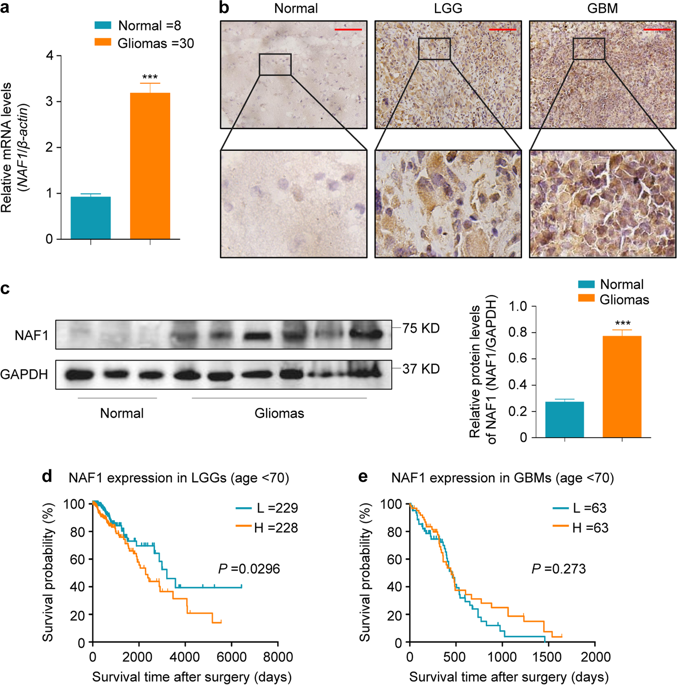Oncogenesis ( IF 5.9 ) Pub Date : 2019-04-01 , DOI: 10.1038/s41389-019-0134-2 Jing Wei , Qi Yang , Jing Shi , Bingyin Shi , Meiju Ji , Peng Hou

|
The H/ACA ribonucleoprotein (RNP) complex noncore subunit NAF1 is an indispensable factor during H/ACA RNP maturation, and one of the widely known functions of H/ACA RNP is modulating ribosome biosynthesis. However, the specific biological role and exact mechanism of NAF1 in human cancers including glioma remain largely unclear. In this study, we found that NAF1 was highly expressed in gliomas relative to normal brain tissues, and demonstrated that increased expression of NAF1 was strongly correlated with poor patient survival. Further studies revealed that NAF1 was transcriptionally regulated by c-Myc, NRF2, and telomerase reverse transcriptase (TERT), which are the key molecules associated with malignant progression of gliomas. Moreover, we demonstrated that NAF1 was a functional oncogene in glioma cells through promoting cell growth in vitro and in vivo, survival, migration, and invasion. Mechanistically, NAF1 acted as a rate-limiting controller of cell growth and invasiveness through enhancing 40S subunit assembly and protein synthesis including c-Myc, NRF2, TERT, POLR1A, and POLR2A. These molecules in turn enhanced the transcription and translation of NAF1, thereby forming positive feedback loops between them to promote malignant phenotypes of glioma cells. In addition, our data also showed that NAF1 depletion could trigger ribosome stress, not only impairing ribosomal biosynthesis but also reactivating p53 signaling via blocking MDM2. Taken together, we demonstrated that NAF1 promotes the tumorigenesis and progression of glioma through modulating ribosome assembly and protein synthesis, and predicted that NAF1 may be a potential therapeutic target and valuable prognostic biomarker in gliomas.
中文翻译:

NAF1表达的增加通过促进蛋白质合成促进神经胶质瘤细胞的恶性表型,并与患者生存不良有关
H / ACA核糖核蛋白(RNP)复合物非核心亚基NAF1是H / ACA RNP成熟期间必不可少的因素,H / ACA RNP的广为人知的功能之一是调节核糖体的生物合成。但是,NAF1在包括胶质瘤在内的人类癌症中的具体生物学作用和确切机制仍不清楚。在这项研究中,我们发现相对于正常脑组织,NAF1在神经胶质瘤中高表达,并证明NAF1的表达增加与不良患者生存密切相关。进一步的研究表明,NAF1受c-Myc,NRF2和端粒酶逆转录酶(TERT)的转录调控,这是与神经胶质瘤恶性进展相关的关键分子。而且,我们证明了NAF1是通过促进体外和体内细胞生长,存活,迁移和侵袭而在神经胶质瘤细胞中起作用的癌基因。从机制上讲,NAF1通过增强40S亚基组装和蛋白质合成(包括c-Myc,NRF2,TERT,POLR1A和POLR2A)充当细胞生长和侵袭性的限速控制器。这些分子反过来增强了NAF1的转录和翻译,从而在它们之间形成正反馈环,从而促进神经胶质瘤细胞的恶性表型。此外,我们的数据还显示,NAF1耗竭可能触发核糖体应激,不仅损害核糖体生物合成,而且还通过阻断MDM2激活p53信号传导。在一起































 京公网安备 11010802027423号
京公网安备 11010802027423号